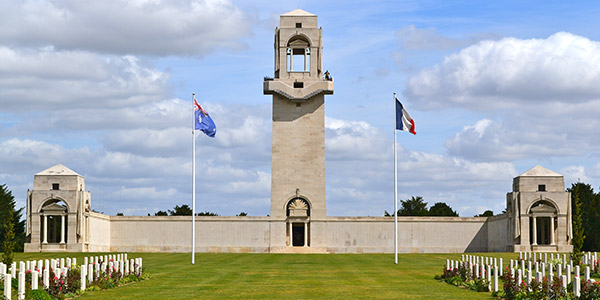A visit to Villers-Bretonneux on the Western Front is a moving an educational experience.
Although it’s often overshadowed by Gallipoli, most Australians are aware of the participation of Australian forces on the Western Front in World War I. However, for many, the details are sketchy. So my wife and I journeyed to the Western Front, to see what it was like and the role that was played by the 1st AIF and other nations.
Our arrival at Charles de Gaulle Airport was late, due to a French air-traffic controllers’ ‘dispute’, and our first drive in the rental car involved braving inclement weather and even more inclement peak-hour traffic. We reached our first base camp very late, in the pitch black of night, at a farm B&B at Aumont, just west of Amiens. We were now in the Somme – a name that, for me, had been evocative since my school days.
Refreshed by our host’s luxurious lodgings and generous, late, but not so petit déjeuner, we travelled east for an hour to Villers-Bretonneux. This is a town of 4000, which we had read still holds a close attachment for Australians; Victorians in particular. I must confess to harbouring a healthy scepticism that, almost a century after the fighting had ceased, the locals would still retain this affinity. But we were not disappointed.
Click NEXT to read more about David’s European experiences.
Our first stop was the famous Victoria School and Museum, a veritable shrine to all things Antipodean. The museum is housed in an unassuming two-storey brick building, with the hall – a rarity in French schools – on the ground floor and the museum on the first floor. We were not prepared for such a detailed, professional and extensive display of photos, models, uniforms, insignia and personal effects – including letters and diaries.
At the far end of the museum space, in a theatrette, we watched a one-hour flickering black-and-white documentary, which provided a crash-course introduction to World War I and the Western Front. So absorbing and informative is the museum that we could have spent all afternoon there; however, we had to leave after several hours and then collided with local parents who were collecting their offspring.
School was over for the day! A quick walk around the compact town centre revealed numerous reminders of Australia; the Melbourne Bar, Robinvale Square – Villers-Bretonneux has been twinned with Robinvale in Victoria since 1984 – and many shops. The bakery has Australian road signs and kangaroos on display in their windows. Even the quintessential corner tabac, where we sat on high chrome stools for the very best coffee, had Australiana above the bar.
It was at Villers-Bretonneux, on ANZAC Day 1918, that General Sir John Monash’s Australian forces halted the German advance west on Amiens. Three months later, the AIF broke through the enemy’s frontline at Le Hamel, north-east of Villers-Bretonneux, and in the next two months liberated a large area stretching east, beyond Peronne. The length of time taken for those operations illustrates just how intense and difficult the fighting must have been.
Our next stop was the massive Australian National Memorial and cemetery, just north of Villers-Bretonneux on the road to Corbie. Despite having to walk the final kilometre, due to road works, the experience was well worth the effort. Situated on a slight rise in the otherwise flat Somme countryside, the site’s 360-degree panorama was very moving – especially late in the day with the soft misty light.
Click NEXT to read more about David’s European experiences.
We walked down manicured lawn aisles between seemingly endless, identical white granite headstones, pausing periodically to read an inscription. The most poignant was “A soldier of the Great War, known to God”. After about an hour, we climbed the 300 stairs in the white sandstone tower, which stands sentinel over the entire memorial. If possible, the view was even more breathtaking; but gazing out over the sea of immaculately maintained graves, mixed emotions competed in our heads and hearts.
We reflected on the 11,000 names, inscribed on the walls below, representing Australians who fell in France and whose final resting places are unknown. It was impossible to drive back to Aumont without having been deeply affected by our experiences in Villers-Bretonneux.
If you only have one day in the Somme, ensure that you don’t fail to visit the little rural town of Villers-Bretonneux, where the admonition, N’oublions jamais l’Australie – do not forget Australia – is strongly adhered to, still.
More
Les Chambres d’Aumont
Address: Le Château 2 rue d’Hornoy, 80640, Aumont
Phone: +33 3 22 90 67 16
Email: stephanie@chambresdaumont.fr
Website: www.chambresdaumont.fr
Musée Franco-Australien
Address: 9 rue de Victoria, 80800 Villers-Bretonneux
Phone: +33 3 22 96 80 79
Email: museeaustralien@neuf.fr
Website: www.museeaustralien.com
First published in Mufti magazine.

